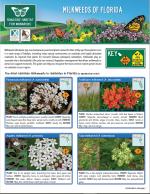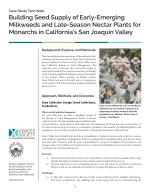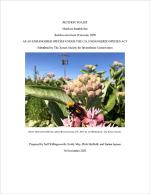As a science-based organization, the Xerces Society produces dozens of publications annually, all of which employ the best available research to guide effective conservation efforts. Our publications range from guidelines for land managers, to brochures offering overviews of key concepts related to invertebrate conservation, from books about supporting pollinators in farmland, to region-specific plant lists. We hope that whatever you are seeking—whether it's guidance on making a home or community garden pollinator-friendly, advice on developing a local pesticide reduction strategy, or detailed information on restoring habitat—you will find it here!
Find Publications
Use the search functions to sort by publication type (books, guidelines, fact sheets, etc.), location, and/or subject (agriculture, gardens, pollinators, pesticides, etc.).
Habitat Installation Guide
These region-and state-specific guidelines provide in-depth practical guidance on how to install and maintain nectar- and pollen-rich habitat for pollinators in the form of wildflower meadow plantings/conservation cover (NRCS Conservation Practice 327) or linear rows of native flowering shrubs/hedgerow plantings (NRCS Conservation Practice 422). Seed mixes and plant recommendations for each region are included in the appendix of each guide.
This form was designed to help with habitat installation planning. For more information see the Habitat Installation Guides.
Creating and Maintaining Healthy Pollinator Habitat
This guidance document was designed to help growers, land managers, and others safeguard pollinator habitat from harmful pesticide contamination. It includes information on selecting habitat sites, as well as ways to maintain clean habitat by limiting and carefully managing pesticide use.
Beneficial insects like predatory ground beetles and wasps, spiders, and lady beetles can provide important natural pest control in a farm or garden setting. Our scouting guides are designed to help you assess the presence of predatory organisms where they hunt or rest – in soils, on vegetation, or on flowers.
Beneficial insects like predatory ground beetles and wasps, spiders, and lady beetles can provide important natural pest control in a farm or garden setting. Our scouting guides are designed to help you assess the presence of predatory organisms where they hunt or rest – in soils, on vegetation, or on flowers.
Beneficial insects like predatory ground beetles and wasps, spiders, and lady beetles can provide important natural pest control in a farm or garden setting. Our scouting guides are designed to help you assess the presence of predatory organisms where they hunt or rest – in soils, on vegetation, or on flowers.
Technical Note
This beneficial insect monitoring protocol consists of three distinct monitoring methods: floral observations, foliar monitoring, and aphid mummy monitoring. Running these monitoring methods in both cropped areas and surrounding habitat may provide the most useful assessment of beneficial insects on the farm as a whole. Using all three methods will yield the most robust data, but each can also be used independently.
Developed the University of California, Davis, Rutgers University, Michigan State University, and The Xerces Society, this guide provides instructions for assessing pollinator habitat quality and diversity by monitoring native bees. It was developed for conservationists, farmers, land managers, and restoration professionals to document how native bee communities change through time in pollinator habitats. It includes an introduction to bee identification, a detailed monitoring protocol, and data sheets for different habitat types.
(AR–2020)
This conservation planning handbook was developed for NRCS planners and landowners in Arkansas to provide guidance for enhancing diversity on farms for the purposes of improving pollination and pest management.
A diversity of milkweed species is found on roadsides, and play an important role in supporting the life cycle of monarchs. This guide can help you recognize the most common native species of milkweed on roadsides in your region.







